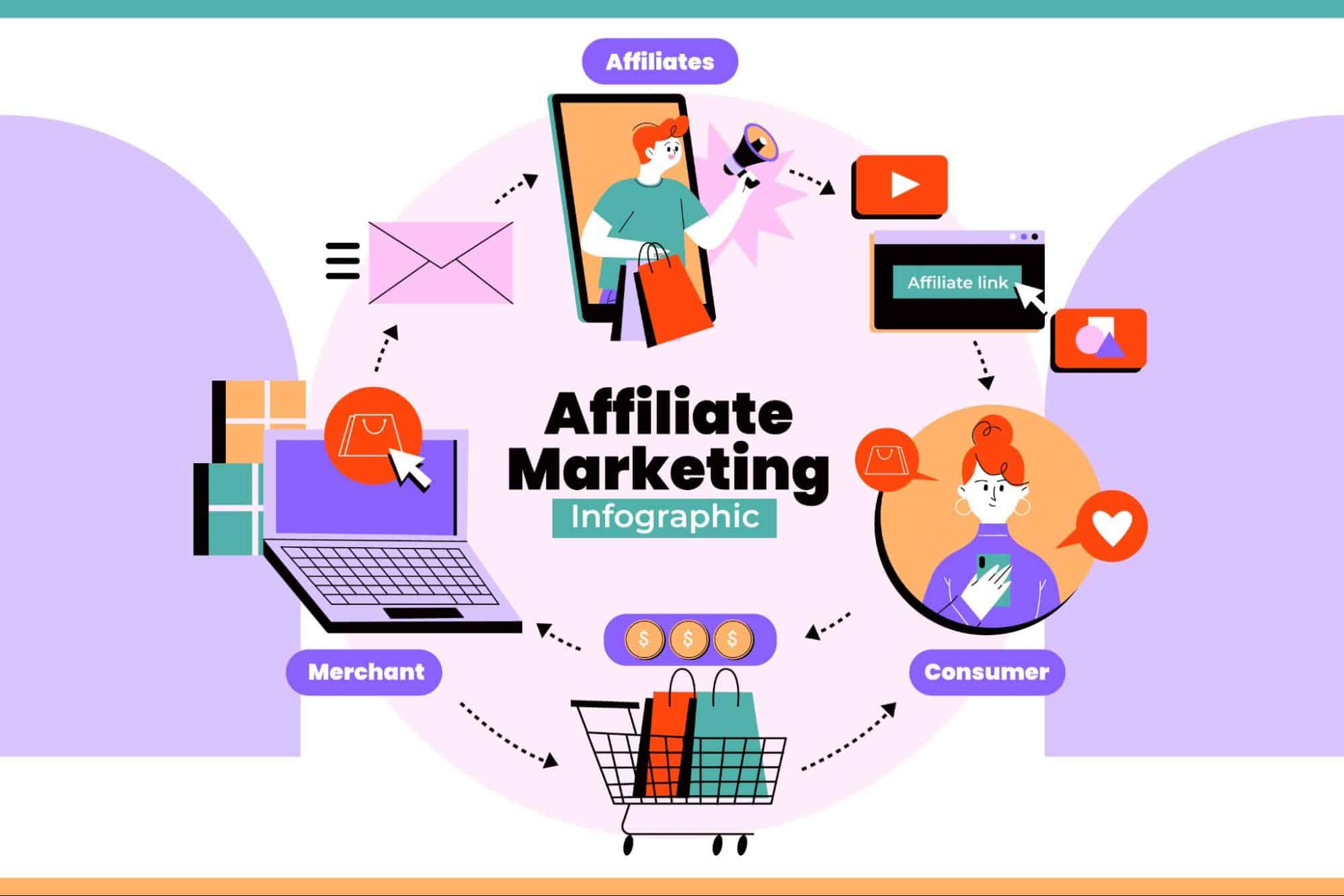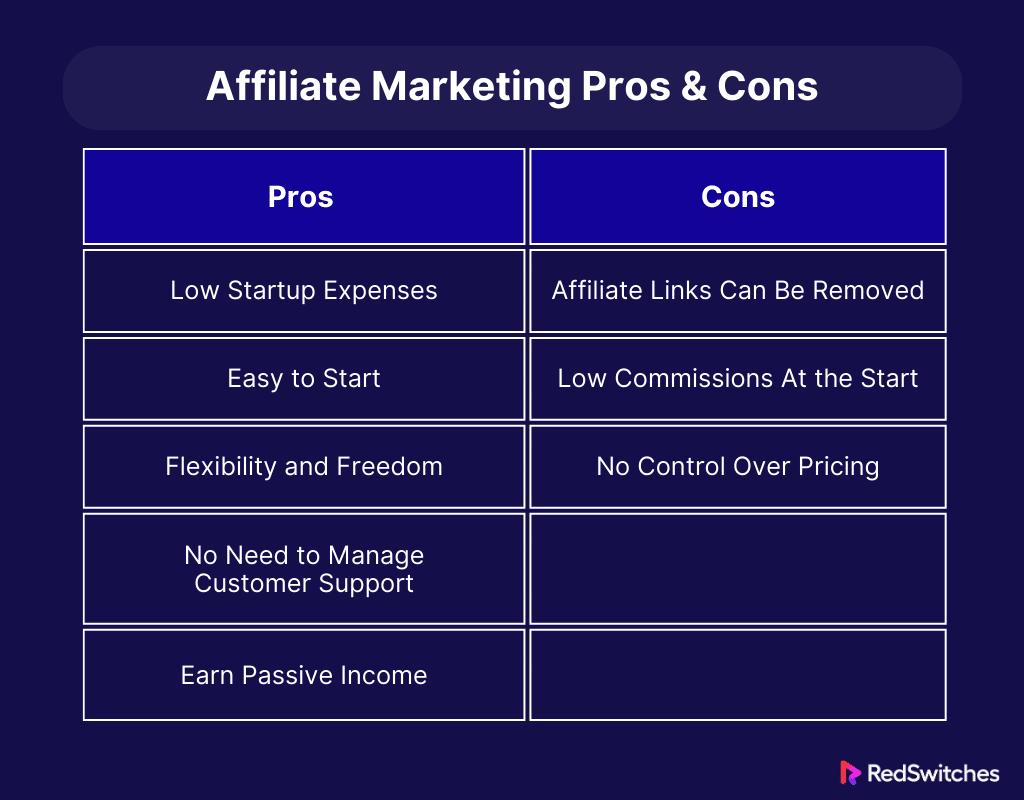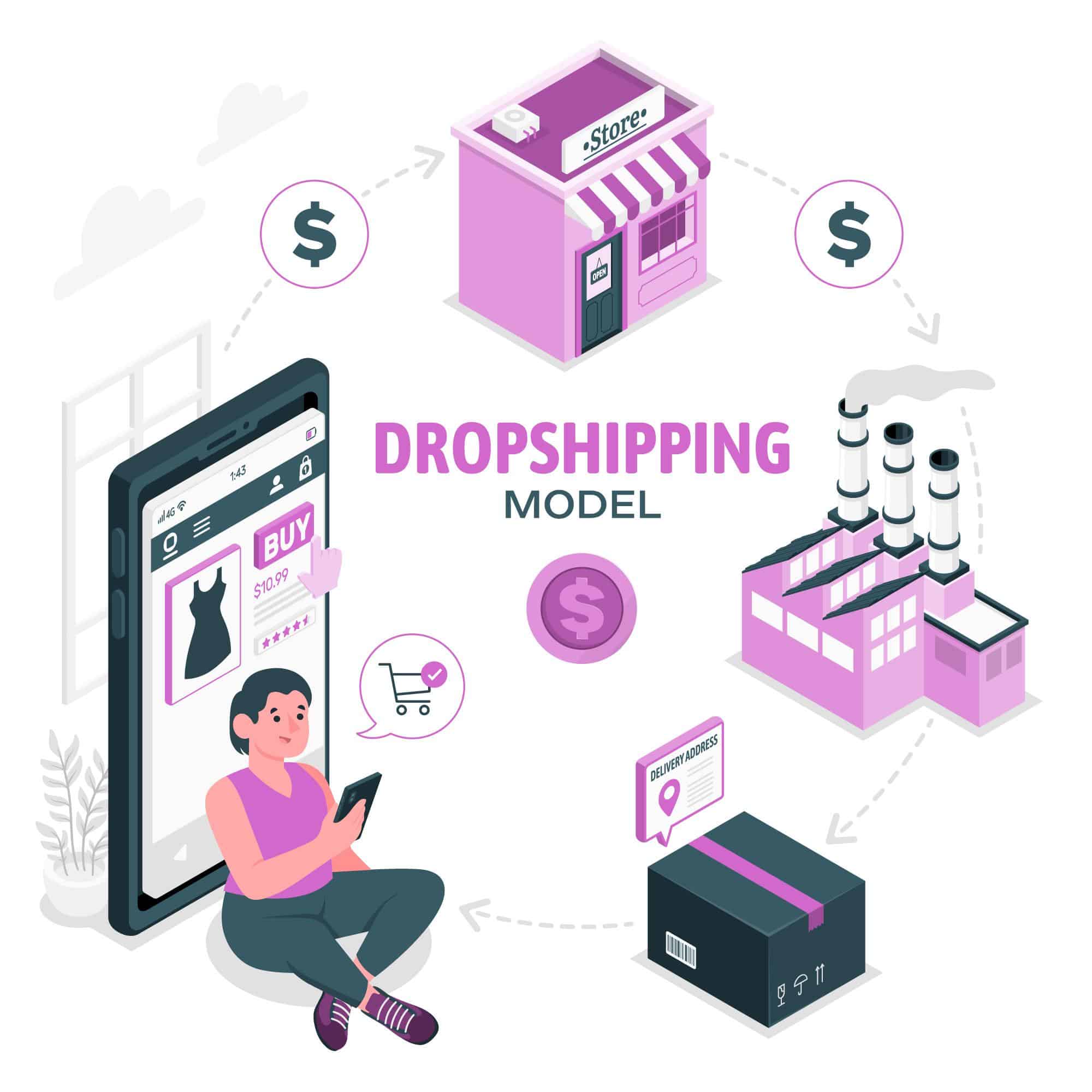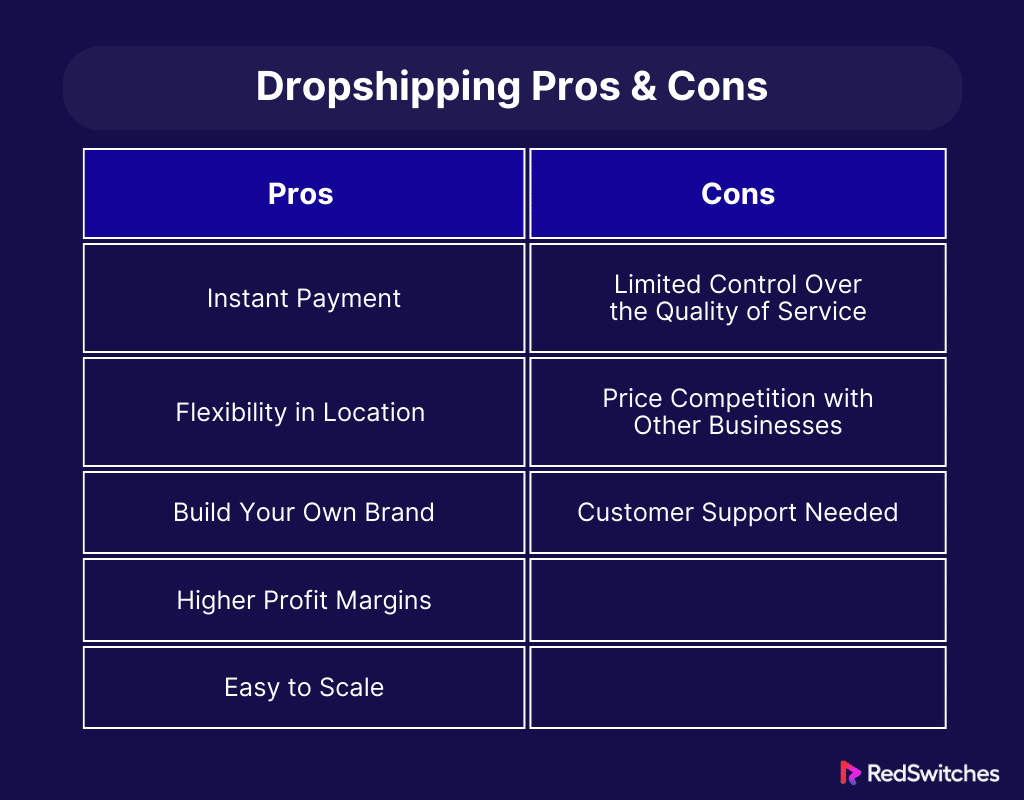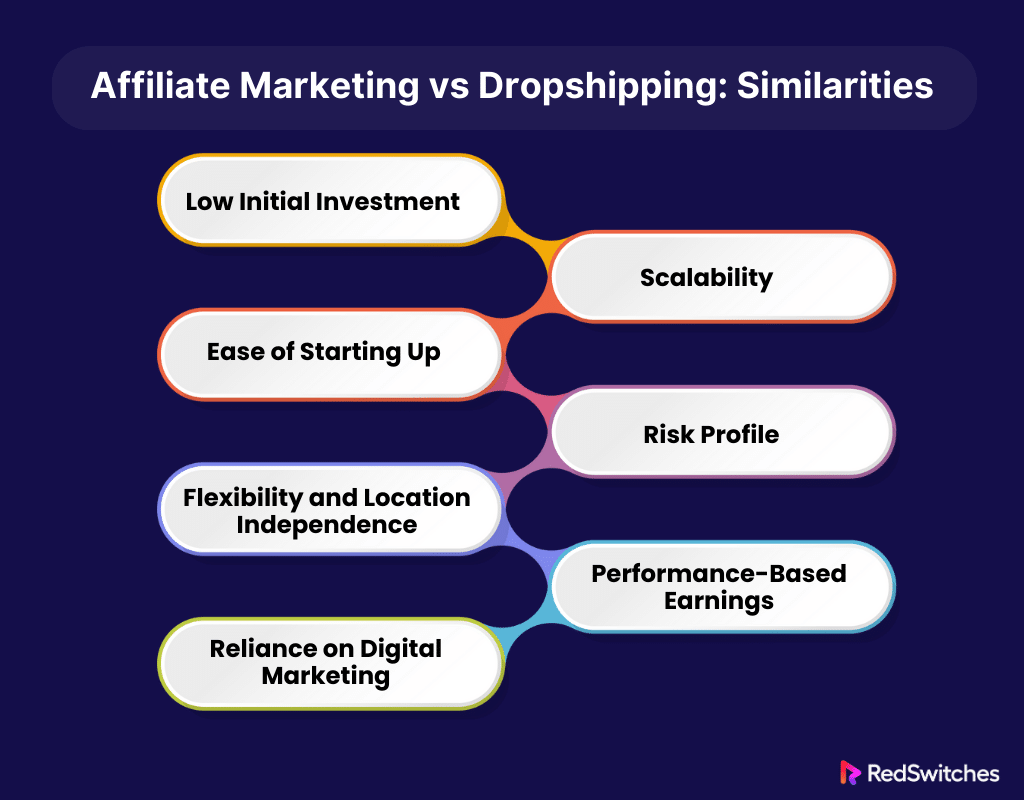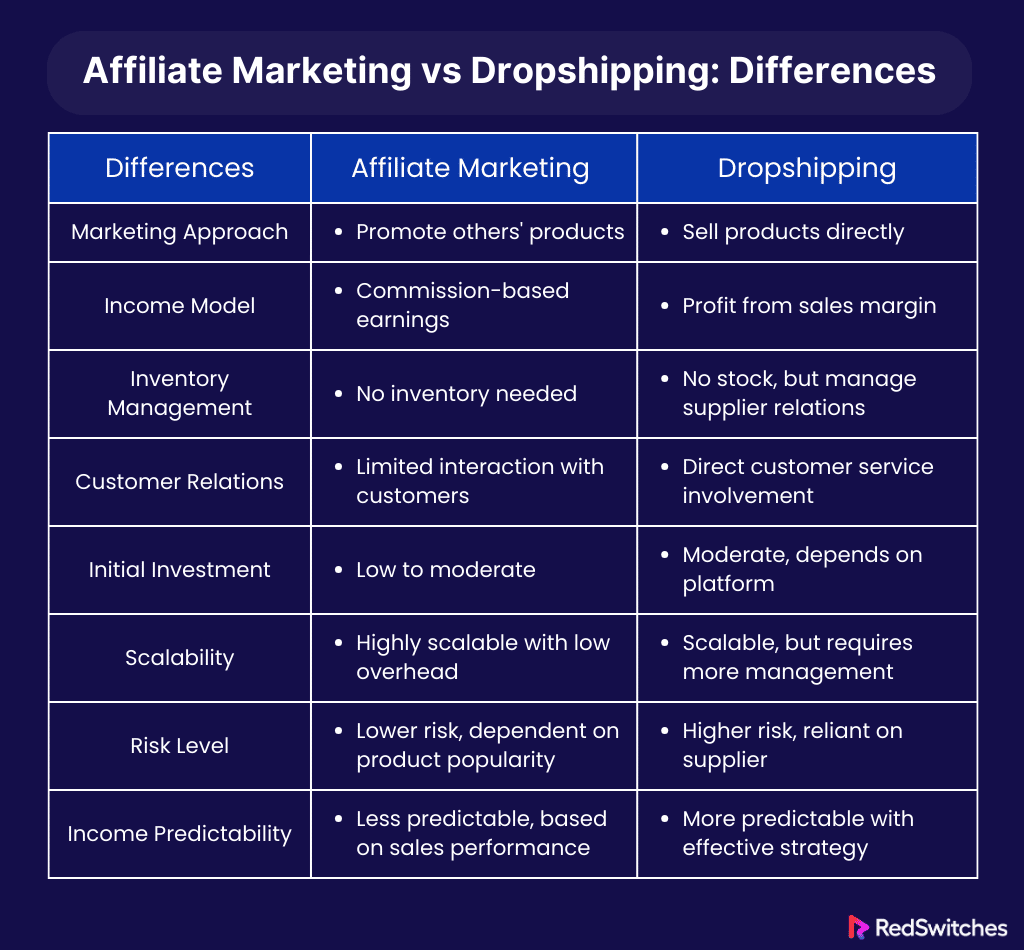Key Takeaways
- Affiliate marketing comes with low startup expenses and an easy initial setup process.
- Dropshipping offers instant payment and flexibility in location.
- Affiliate marketing pros include low startup costs and simplicity, making it accessible, but early commissions may be low, and pricing control is lacking.
- Dropshipping pros include instant payment and location flexibility are advantageous, but quality control and price competition are concerns.
- Affiliate marketing cons are that affiliate links may be removed while it is easy to start, and initial commissions can be low with no control over pricing.
- Dropshipping cons include quality control issues and price competition pose challenges, necessitating customer support and brand-building efforts.
- Dropshipping vs affiliate marketing differ in marketing approach, income model, inventory management, and customer relations strategies.
In the rapidly growing online entrepreneurship world, two business models, Affiliate Marketing and Dropshipping, have taken center stage. According to experts’ predictions, the affiliate marketing industry value could reach $40 billion by 2030, whereas dropshipping is anticipated to reach a market size of $476.1 billion from 2021 to 2026.
Both business models offer unique pathways to success in the digital marketplace, catering to different skills, interests, and business goals. Affiliate marketing revolves around promoting products and earning a commission for each sale or lead, while dropshipping involves selling products directly to buyers without holding inventory.
As entrepreneurs and businesses weigh their options between affiliate marketing vs dropshipping, understanding each model’s nuances, benefits, and challenges becomes crucial. This blog will discuss the difference between affiliate marketing vs dropshipping to help you pick a business model that aligns with your personal strengths and market opportunities.
Table of Contents
- Key Takeaways
- What is Affiliate Marketing?
- What is Dropshipping?
- Affiliate Marketing vs Dropshipping: Similarities
- Affiliate Marketing vs Dropshipping: Differences
- Affiliate Marketing vs Dropshipping: Marketing Approach
- Affiliate Marketing vs Dropshipping: Income Model
- Affiliate Marketing vs Dropshipping: Inventory Management
- Affiliate Marketing vs Dropshipping: Customer Relations
- Affiliate Marketing vs Dropshipping: Initial Investment
- Affiliate Marketing vs Dropshipping: Scalability
- Affiliate Marketing vs Dropshipping: Risk Level
- Affiliate Marketing vs Dropshipping: Income Predictability
- Affiliate Marketing or Dropshipping – Which Is Better?
- Conclusion – Affiliate Marketing vs Dropshipping
- FAQs
What is Affiliate Marketing?
Credits: Freepik
Before we explore the difference between dropshipping vs affiliate marketing, it is important to understand what dropshipping and affiliate marketing are.
Affiliate marketing is an advertising strategy where business owners pay external partners and affiliates to direct traffic to their offerings through the affiliate’s marketing efforts. This method hinges on the principle of revenue sharing. For instance, if a company has a product and wants to increase sales, it can offer promoters/affiliates a financial incentive through an affiliate program.
Affiliates earn a commission for every click, sale, or lead generated through their unique referral links. This model benefits both the company and the affiliate: the company gains increased exposure and sales, and the affiliate earns money from their marketing efforts, typically without the need to develop products or services of their own. Affiliate marketing leverages the power of digital networks and social media, making it a popular tactic in the e-commerce and online content industries.
Also Read: The Ultimate Guide To Starting An Ecommerce Business In 2024.
Affiliate Marketing Pros
Let’s now explore the advantages of affiliate marketing.
Low Startup Expenses
One of the most standout aspects of affiliate marketing is its low barrier to entry in terms of finances. Unlike traditional business models, affiliate marketing doesn’t require a hefty investment. There’s no need to develop, manufacture, or stock products, which typically entails a significant upfront investment.
Instead, the primary focus is setting up a digital platform, which can often be done with minimal cost. Even domain hosting and website design have become more affordable than ever, making affiliate marketing accessible to virtually anyone.
Easy to Start
Ease of initiation is another key advantage. Starting an affiliate marketing venture doesn’t require specialized training or a business degree. The main prerequisites are basic digital literacy, an in-depth understanding of your target audience, and the skill to create engaging content.
Most affiliate programs are straightforward to join. They provide affiliates with unique tracking links and marketing material. Whether you’re a seasoned blogger, a social media influencer, or just starting, affiliate marketing offers a clear and manageable path to enter the online business world.
Flexibility and Freedom
Flexibility and freedom draw many to affiliate marketing. As an affiliate marketer, you’re your own boss – you create your schedule, pick the products you want to promote and work from anywhere with an internet connection.
This flexibility extends to your marketing strategies as well. You can test your luck with different types of content, platforms, and promotional techniques to see what resonates best with your audience. This level of autonomy and flexibility is hard to find in traditional employment settings.
No Need to Manage Customer Support
Another key pro is the absence of direct involvement in customer service. As an affiliate, you link the consumer with the product or service. Once a sale is made, handling customer queries, complaints, or returns falls on the merchant or product creator.
This detachment allows you to focus solely on the marketing aspect without being bogged down by the intricacies of customer support. This can be both time-consuming and challenging.
Earn Passive Income
The most compelling advantage of affiliate marketing is the potential for earning passive income. With a well-strategized approach, your affiliate content can generate sales and earn commissions long after publication.
This aspect of earning while you sleep makes affiliate marketing especially appealing. It’s worth noting that a substantial passive income stream requires consistent effort in content creation and SEO strategies to drive traffic to your affiliate links.
Also Read: 50 Top Trending Products to Sell Online At Your Ecommerce & Dropshipping Store in 2024
Affiliate Marketing Cons
Credits: FreePik
After knowing the advantages of affiliate marketing, here are some of its cons.
Affiliate Links Can Be Removed
One of the significant risks in affiliate marketing is reliance on third-party platforms or merchants. Your income is tied to the affiliate links you share as an affiliate. However, these links, and indeed the products or services you promote, can be subject to change without notice. Companies may discontinue products, change affiliate program policies, or even cease operations. Such changes can lead to removing affiliate links, directly impacting your revenue stream.
This volatility demands flexibility and adaptability from the affiliate marketer. It’s essential to diversify the products and merchants you work with and regularly monitor changes in affiliate programs. Building a diverse portfolio of affiliate products can cushion the impact if one link becomes defunct.
Low Commissions At the Start
Entering the affiliate marketing world often means starting at the bottom, where commission rates can be modest. High-ticket items or popular brands may offer more attractive commissions, but they are also highly competitive and may require established credibility and a larger audience to be successful.
For newcomers, this means starting with lower commissions and gradually building up their platform. This phase requires patience and consistent effort in content creation, audience engagement, and strategic marketing. The key is to focus on building a loyal audience and establishing authority in your niche, which can eventually lead to higher-paying opportunities and partnerships.
No Control Over Pricing
Affiliate marketers do not have control over the pricing and final sale of the products they promote. This lack of control can be a major drawback, especially when compared to models like dropshipping, where the seller sets the prices. The set commission rates mean that your earning potential is directly tied to the pricing policies of the merchant.
To mitigate this, successful affiliates often focus on volume (generating many sales) or target products with higher value or commission rates. Choosing affiliate programs that go with your audience’s interests and purchasing power is also essential, ensuring that the products you promote are appealing and accessible to your followers.
What is Dropshipping?
Credits: FreePik
Dropshipping is a retail fulfillment method where an online store doesn’t hold the products it sells in its inventory. Instead, when a store following the dropshipping model sells, it buys the item from a third party and has it shipped directly to the buyer. This allows them to be free from the hassle of handling the product directly. This model significantly reduces the entry barriers to starting a retail business because it eliminates the need for substantial upfront capital to purchase inventory and for a physical space to store it.
Dropshipping stands out for its low overhead, as most operational costs are related to marketing and customer service. However, this convenience comes with challenges, such as less control over inventory, shipping times, and product quality. Dropshipping has become popular in e-commerce, allowing entrepreneurs to launch online stores with a wide range of products without significant initial investments.
Want to learn more about what dropshipping is? Read our informative blog, ‘Understand What Is Dropshipping In 15 Minutes.’
Dropshipping Pros
Dropshipping offers numerous advantages, as exemplified below.
Instant Payment
One of the most immediate benefits of dropshipping is the instant payment feature. Unlike traditional retail models, dropshipping allows you to receive customer payments as soon as they purchase.
This immediate cash flow is crucial for maintaining the health of your business, enabling you to manage expenses, reinvest in marketing, or diversify your product offerings without waiting for lengthy payment cycles. Instant payment enhances liquidity, providing the necessary funds to react swiftly to market changes or business opportunities.
Flexibility in Location
Dropshipping offers unparalleled flexibility in terms of location. You can operate your business anywhere since you don’t need to manage physical inventory or a brick-and-mortar store. All you need is a stable internet connection. This mobility allows for a greater work-life balance and the opportunity to tap into global markets.
Whether you’re a digital nomad or simply prefer working from the comfort of your home, dropshipping accommodates a lifestyle not anchored to a single location, broadening the horizons for your business outreach.
Build Your Own Brand
Dropshipping offers you the opportunity to build and cultivate your own brand. Unlike being an affiliate or a reseller for existing products, dropshipping allows you to market products under your brand name.
This freedom in branding enables you to create a distinct identity in the market, tailor your marketing strategies to your target audience, and build a loyal customer base. A strong brand can be the defining factor in the long-term success of your e-commerce venture.
Higher Profit Margins
Dropshipping can offer significantly higher profit margins compared to traditional retail models. Since you don’t incur costs associated with manufacturing, stocking, or maintaining inventory, you can often enjoy a larger margin on each sale.
This aspect is particularly beneficial when dealing with luxury or high-ticket items. The ability to adjust pricing dynamically based on market trends, competition, and demand can further optimize your profitability.
Easy to Scale
Scaling a business in the dropshipping model is considerably easier and less risky than in traditional retail. As sales increase, the business model accommodates growth without additional inventory or storage space investment.
This scalability allows you to expand your product range, enter new markets, or increase your marketing efforts without a proportional increase in operational complexities. The dropshipping model can adapt and grow with your business aspirations, making it an ideal choice for those looking to scale quickly and efficiently.
Dropshipping Cons
Credits: Pexels
While dropshipping offers various benefits, it also presents certain drawbacks to consider.
Limited Control Over the Quality of Service
One of the most significant drawbacks of dropshipping is the limited control over the quality of service. Since the dropshipper is not in charge of inventory management or order fulfillment, they rely entirely on third-party suppliers to maintain product quality and ensure timely delivery. This reliance can lead to issues if the supplier fails to meet standards, resulting in poor customer experiences.
Without direct oversight, dropshippers often find themselves at the mercy of their suppliers’ reliability and professionalism, which can vary greatly. This lack of control can lead to inconsistent product quality, delayed shipments, and damage to the business’s reputation.
Price Competition with Other Businesses
The dropshipping model is known for its low barriers to entry, which means a highly competitive market. Many dropshippers sell similar, if not identical, products since they are sourced from common suppliers. This similarity leads to intense price competition, as each business strives to attract customers by offering lower prices.
The result can be a race to the bottom, where profit margins become razor-thin. For dropshippers, it becomes challenging to differentiate their offerings and maintain profitability, especially when competing against more prominent e-commerce players who can afford to slash prices due to higher volume sales or better supplier agreements.
Customer Support Needed
Another challenge in dropshipping is robust customer support. Since the drop shipper is the customer’s primary point of contact, they must handle all customer inquiries, complaints, and returns. The lack of direct control over inventory and shipping compounds this responsibility. Issues like shipping delays, out-of-stock products, or items not matching their description are not uncommon in dropshipping.
These issues require a dedicated customer service effort, which can be time-consuming and costly. Providing effective customer support can be particularly challenging for small businesses or solo entrepreneurs, requiring skills and resources they may not have.
Also Read: Wix Vs Shopify – Which Is The Ultimate Platform In 2024?
Affiliate Marketing vs Dropshipping: Similarities
Although affiliate vs dropshipping business models can differ significantly, they are similar in several ways. Below are some similarities between affiliate marketing and dropshipping:
Low Initial Investment
One of the most significant similarities between Affiliate Marketing and Dropshipping is the low barrier to entry in terms of financial investment. Neither model requires a significant upfront capital. In Affiliate Marketing, you promote other people’s products, so purchasing inventory is unnecessary.
Similarly, you sell products without stocking them in Dropshipping, as the supplier handles the inventory and shipping. This low initial investment makes both models attractive, especially for new entrepreneurs.
Ease of Starting Up
Both models are relatively easy to start. You don’t need extensive technical skills or business experience. Affiliate Marketing is about setting up a platform to promote products. In Dropshipping, you set up an online store but don’t have to deal with physical products directly. This ease of setup appeals to individuals looking to start an online business quickly.
Flexibility and Location Independence
Affiliate Marketing and Dropshipping offer high flexibility and location independence. Both can be managed from anywhere worldwide, as long as you have an internet connection. This flexibility particularly appeals to digital nomads and those seeking a work-from-home lifestyle.
Reliance on Digital Marketing
Both business models heavily rely on digital marketing to drive traffic and sales. Whether through SEO, content marketing, social media advertising, email marketing, affiliate marketing, or dropshipping, success depends on your ability to market products effectively online. This reliance on digital marketing means that skills in this area can be beneficial in either model.
Scalability
Both models are scalable but without the typical constraints of a traditional business. In Affiliate Marketing, you can scale by promoting more products or enhancing your marketing strategies to reach a wider audience. In Dropshipping, scaling can be achieved by adding more products to your store or expanding into new markets. Both models’ lack of physical inventory makes scaling up more manageable than traditional retail businesses.
Risk Profile
Affiliate Marketing and Dropshipping have a relatively low-risk profile compared to other business models. Since you don’t hold inventory in either model, you are less exposed to the risks associated with excess stock and changing market trends. This lower risk is a significant draw for individuals cautious about investing large sums of money or getting stuck with unsold inventory.
Performance-Based Earnings
In both models, your earnings are primarily performance-based. In affiliate marketing, your income depends on how effectively you can convert your audience into buyers using your affiliate links. In Dropshipping, your profit depends on your ability to sell products at a markup from their wholesale price. In both cases, there is a direct correlation between your marketing efforts and your earnings.
Also Read: Shopify Vs WordPress: eCommerce Comparison 2023.
Now that we have discussed what affiliate marketing vs dropshipping are, their pros and cons, and similarities, let’s explore the differences between affiliate marketing vs dropshipping.
Affiliate Marketing vs Dropshipping: Differences
Looking to understand the difference between affiliate marketing and dropshipping? Below are the eight key differences between dropshipping vs affiliate marketing.
Affiliate Marketing vs Dropshipping: Marketing Approach
In comparing Affiliate Marketing and Dropshipping, understanding their distinct marketing approaches is crucial.
Affiliate Marketing
The essence of affiliate marketing lies in its strategic promotional efforts. As an affiliate marketer, your main job is marketing and advertising products or services for other businesses. Using various digital marketing techniques like content marketing, SEO, and email marketing, you direct potential customers to the products through unique affiliate links.
The focus is on building a solid online presence and audience trust, as your income hinges on how effectively you can persuade your audience to purchase through your links. You don’t handle the product directly, nor do you deal with customer service issues related to the product.
Dropshipping
Marketing is also crucial in dropshipping but is intertwined with direct sales. As a dropshipper, you establish an online store and display products sourced from suppliers. Your marketing efforts aim to attract customers to your store and convince them to purchase. Unlike affiliate marketing, you’re involved in the entire sales process – from showcasing products on your website to managing customer inquiries and feedback.
The marketing in dropshipping is more product-focused and requires a deeper understanding of e-commerce tactics, customer service, and conversion optimization.
Affiliate Marketing vs Dropshipping: Income Model
When examining Affiliate Marketing versus Dropshipping, it’s essential to analyze their differing income models.
Affiliate Marketing
The income model in affiliate marketing is predominantly commission-based. You earn a percentage of the sale for each customer who purchases through your affiliate link. This model provides flexibility and can be a passive income stream, as content containing affiliate links can continue to produce revenue long after it’s been created.
However, your income is directly tied to the performance of your marketing strategies and the purchasing decisions of your audience. The commission rate can vary depending on the products and the affiliate program terms.
Dropshipping
The income model in drop shipping involves buying products from suppliers at a wholesale price and selling them at a retail price. Your profit is the margin between these two prices. Unlike affiliate marketing, where commissions are fixed percentages, dropshipping enables you to control the pricing of your products.
This model can generate high-profit margins, but it also involves managing costs such as website maintenance, advertising, and, in some cases, shipping fees. Financial success in dropshipping heavily depends on your ability to market products effectively and manage an online store.
Affiliate Marketing vs Dropshipping: Inventory Management
Credits: Pexels
In the comparison between Affiliate Marketing and Dropshipping, evaluating their approaches to inventory management is fundamental.
Affiliate Marketing
Inventory management is a non-issue for the affiliate marketer. As an affiliate, your role is to connect potential customers to the products or services offered by a business or merchant. The responsibility of maintaining inventory, tracking stock levels, and managing product orders lies entirely with the merchant. This aspect of affiliate marketing makes it an attractive option for those who prefer not to deal with the complexities and financial constraints of inventory management.
Dropshipping
Dropshipping involves a different approach to inventory management. While dropshippers do not physically store products, they are responsible for choosing and promoting these products on their online store. When a customer orders, the drop shipper purchases the item from a third-party supplier, who then ships it directly to the customer.
Though this eliminates the need for physical storage, dropshippers must remain vigilant about their suppliers’ inventory levels, ensuring that advertised products are available and avoiding backorders.
Affiliate Marketing vs Dropshipping: Customer Relations
While contrasting Affiliate Marketing with Dropshipping, delving into their strategies for managing customer relations becomes pivotal.
Affiliate Marketing
The direct customer relationship is typically minimal or non-existent in terms of affiliate marketing. Affiliate marketers focus on creating compelling content and effective marketing strategies to drive traffic to the merchant’s site. Once the potential customer has clicked on the affiliate link and is redirected to the merchant’s site, the merchant handles all aspects of customer interaction, sales, and post-sales support.
This setup allows affiliate marketers to concentrate solely on marketing without the need to engage in customer support or relationship management.
Dropshipping
Dropshipping requires a more hands-on approach to customer relations. As a dropshipper, you are the face of your store. Customers purchase products from your website without knowing about the third-party supplier. Therefore, all customer interactions – from answering queries and handling sales to dealing with complaints and managing returns – are your responsibility.
This aspect of dropshipping demands a significant commitment to customer service and relationship management, which can be both challenging and rewarding.
Affiliate Marketing vs Dropshipping: Initial Investment
In comparing Affiliate Marketing to Dropshipping, assessing their initial investment requirements is essential.
Affiliate Marketing
Affiliate marketing stands out for its low barrier to entry in terms of initial investment. It primarily involves setting up a digital platform to promote products. The cost can range from almost zero (using free platforms and social media) to a moderate amount if you opt for a professional website with paid hosting and domain.
The expenses in affiliate marketing are mostly related to creating and distributing content and potentially in digital marketing strategies to drive traffic to your platform. However, these costs are typically much lower compared to physical business models.
Dropshipping
Dropshipping requires a slightly higher initial investment than affiliate marketing. While you don’t need to invest in inventory, you need an e-commerce platform to list and sell products. This often involves subscription fees for platforms like Shopify or WooCommerce.
Dropshipping also demands upfront costs in setting up your online store, including website design, domain purchase, and possibly paid plugins or themes. Another significant expense in dropshipping is marketing. Since the success of dropshipping relies on attracting customers to your store, investment in ads, SEO, and other marketing strategies is essential.
Affiliate Marketing vs Dropshipping: Scalability
Credits: FreePik
In the comparison of Affiliate Marketing and Dropshipping, exploring their scalability capabilities is vital for assessing long-term growth potential.
Affiliate Marketing
Scalability in affiliate marketing depends mainly on your ability to grow your audience and diversify your affiliate offerings. Since it doesn’t require handling products or customer service, scaling up often means expanding your content and reaching a broader audience.
This can be achieved through investing in better content creation and SEO and leveraging multiple platforms. The scalability of affiliate marketing is tied to your marketing skills and the effectiveness of your content strategy. The more you can grow and engage your audience, the more affiliate sales you can generate.
Dropshipping
Dropshipping offers a different scalability model. It allows for significant growth in terms of sales and revenue, but this also comes with increased complexities. Scaling a dropshipping business often means adding more products, handling more orders, and potentially dealing with more suppliers.
While you don’t need to manage inventory, you do need to ensure your supply chain is robust and can handle increased order volumes. Customer service also becomes more critical as your business grows. Scaling in dropshipping may require reinvesting profits into more sophisticated e-commerce tools, customer service staff, and advanced marketing strategies.
Affiliate Marketing vs Dropshipping: Risk Level
When weighing Affiliate Marketing against Dropshipping, evaluating their respective risk levels is crucial for informed decision-making.
Affiliate Marketing
Affiliate marketing is often seen as a low-risk model. You don’t need to invest in product development or inventory as an affiliate. Your primary role involves marketing and promoting products for another business, earning a commission for each sale made through your referral links.
The financial risk is minimal; the principal investment is your time and effort in creating compelling content and building an audience. This model is particularly attractive for those who prefer to avoid the complexities and financial uncertainties of handling physical products.
Dropshipping
Dropshipping involves a higher level of risk. Although you don’t need to maintain inventory, you are still responsible for the business’s operational aspects, including managing customer orders, handling returns, and ensuring product quality. These responsibilities introduce risks such as dealing with unreliable suppliers, customer dissatisfaction, and potential refund issues.
The financial risk in dropshipping can be higher than affiliate marketing, as you need to invest in building and maintaining your e-commerce platform and potentially in advertising to attract customers.
Affiliate Marketing vs Dropshipping: Income Predictability
Examining their income predictability is essential when comparing Affiliate Marketing to Dropshipping to understand revenue stability.
Affiliate Marketing
Income predictability in affiliate marketing can be variable. Your earnings are directly tied to the performance of your marketing strategies and affiliate links. It requires building a substantial and engaged audience, and income can fluctuate based on factors like changes in consumer behavior, affiliate program terms, and market trends.
While successful affiliate marketers can generate significant income, building a steady income stream often takes time and consistent effort.
Dropshipping
Dropshipping can offer a more predictable income once the business is established. This is especially true if you have a steady stream of customers and reliable suppliers. However, it’s subject to market competition and the need to attract customers, often through paid advertising continually.
Factors like product pricing, shipping costs, and supplier reliability also influence profit margins in dropshipping. While dropshipping can potentially provide a more consistent income than affiliate marketing, it requires careful management and a strategic approach to maintain profitability.
Do you want to know about the best selling dropshipping products? Read our blog ‘Discover The 20 Best Dropshipping Products Of 2023.’
Affiliate Marketing or Dropshipping – Which Is Better?
Credits: Pexels
Still confused about which is better between affiliate marketing vs dropshipping? Read below for answers:
Affiliate Marketing
Affiliate Marketing is all about promoting other people’s products. As an affiliate marketer, you earn commissions for every sale or lead your marketing efforts generate. This model is highly attractive for those who excel in marketing and content creation.
It allows you to focus on what you do best – creating compelling content and persuasive marketing strategies – without the hassle of inventory management or customer service. The key to success in affiliate marketing lies in building a strong online presence, whether through a blog, social media, or a YouTube channel, and effectively monetizing this audience.
Dropshipping
Dropshipping is a retail fulfillment method where you sell products directly to customers without holding inventory. The product is shipped directly from the supplier to the customer after purchase. This model is ideal for entrepreneurs who want more control over their product offerings and pricing strategies.
Dropshipping requires a more hands-on approach, from setting up an online store and choosing the right products to customer service and managing supplier relationships. The profit potential in dropshipping can be significant, but it also comes with the challenges of maintaining product quality, managing shipping times, and handling customer inquiries.
Final Verdict – Which is Better
The answer to which is better – dropshipping or affiliate marketing – depends on your personal goals, skills, and resources. If you’re a savvy marketer who enjoys content creation and has a knack for building audiences, affiliate marketing might be your path to success. Dropshipping could be more up your alley if you’re drawn to the world of e-commerce and are eager to have more control over your business, from product curation to customer interaction.
Conclusion – Affiliate Marketing vs Dropshipping
From this exploration of dropshipping vs affiliate marketing, it is evident that whatever business model you choose between affiliate marketing vs dropshipping, the key to success lies in robust and reliable digital infrastructure. This is where RedSwitches steps in.
RedSwitches provides tailored hosting solutions that cater to affiliate marketers and dropshippers, ensuring your online business runs smoothly, efficiently, and without interruption.
With our state-of-the-art hosting services, you can focus on the growth of your business with the assurance that your digital foundation is solid, scalable, and supported by a team of experts. Explore our services today and empower your Affiliate Marketing or Dropshipping journey with the right tools and support.
FAQs
Q. Is dropshipping better than affiliate marketing?
When comparing affiliate marketing vs dropshipping, one must understand that the answer to this depends on your individual preferences and business goals. Dropshipping offers more control over pricing and branding but requires handling customer service and logistics. Affiliate marketing involves less responsibility regarding inventory and customer service.
Q. What is more profitable than dropshipping?
Profitability can vary greatly depending on the business model and execution. While dropshipping can be profitable, other models, like creating your product line or offering digital products and services, can potentially offer higher margins. These models, however, may require more initial investment and development time. The key is finding a niche and a business model that aligns with your strengths and market demand.
Q. Which is better, eCommerce or affiliate marketing?
eCommerce store and affiliate business both serve different roles. eCommerce, which includes dropshipping, involves selling products directly and managing inventory. It gives you more control over product offerings and customer experience. Affiliate marketing is about promoting others’ products for a commission. This can be preferable for those looking to avoid the hassles of inventory management. The better option depends on your desire for control, risk tolerance, and interest in direct sales versus marketing.
Q. What are the pros and cons of dropshipping vs affiliate marketing?
Unlike affiliate marketing, which requires minimal investment but depends on product promotion for earnings. Dropshipping offers low startup costs and inventory management but involves higher fulfillment costs.
Q. How does the affiliate marketing model differ from the dropshipping model?
In affiliate marketing, marketers earn a commission for driving sales to a merchant’s website. Dropshipping involves directly selling products and handling customer orders through a supplier.
Q. How do profit and control over products compare between the two models?
Dropshipping typically offers higher profits and more product control, suitable for building a brand. Affiliate marketing provides passive income through commissions with limited control over products.
Q. What about starting costs and flexibility?
Affiliate marketing requires lower initial investment and offers high flexibility in product promotion. Dropshipping needs a moderate upfront investment with the flexibility to choose and brand products.
Q. What challenges do dropshipping and affiliate marketing face?
Dropshipping depends on supplier reliability for product quality and shipping, while affiliate marketing depends on product performance and affiliate network reliability for payouts.
Q. How do they compare in long-term viability and earnings?
Both can be sustainable and profitable. Dropshipping scales with sales and supply optimization. Affiliate marketing grows through a strong referral strategy, offering passive income opportunities.
Q. Can I start a dropshipping business and become an affiliate marketer simultaneously?
You can run a dropshipping store and join affiliate programs to promote complementary products, expanding your revenue streams through both business models.
Q. What are the pros of affiliate marketing?
The pros of affiliate marketing include the following:
- Low startup costs.
- No need to hold inventory.
- Passive income potential.
- The ability to work from anywhere with an internet connection.
Q. How can I start an affiliate marketing business?
To start an affiliate marketing business, you must choose a niche or product to promote. Next, join an affiliate program, create an affiliate website or content platform, drive traffic to your site, and optimize for conversions to earn affiliate commissions.
Q. Is dropshipping a low-risk business model?
Dropshipping is considered a low-risk business model because you do not need to invest in inventory upfront and only purchase products from suppliers after securing customer orders.
Q. How can I find dropshipping suppliers?
You can find dropshipping suppliers by researching online directories, attending trade shows, contacting manufacturers directly, or using dropshipping platforms to connect with verified suppliers.
Q. What are some marketing costs associated with affiliate marketing?
Marketing costs associated with affiliate marketing may include expenses for advertising, content creation, SEO optimization, email marketing, social media promotion, and affiliate program fees.

